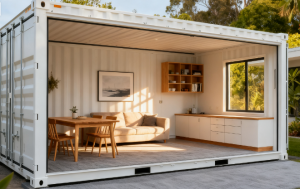Against the backdrop of escalating global construction costs and increasingly tight project timelines, foldable container are spearheading a revolution in construction efficiency in North America and Europe. This innovative construction solution not only precisely addresses the unique challenges of the European and American markets but also stands out with superior environmental performance and adaptability, making it the go-to choice for modern construction and temporary space needs.
Foldable Containers: A Precise Response to Points in the European and American Markets
Soaring Logistics and Storage Costs
Traditional container transport has long faced a fundamental challenge in North America and Europe: the exant logistics costs resulting from low space utilization. Standard box containers take up the same amount of space during transport whether they are empty or full, leading to massive avoidable losses for European American businesses each year.
Foldable containers have revolutionized this scenario with their precisely engineered design. The containers can be reduced in volume by an astonishing 7580% when folded, which translates to a 300-400% increase in transport capacity per trip, directly leading to a significant decrease in logistics costs.
For energy projects that frequently relocate across the vast expanse of North America and construction companies operating in multiple European countries, this space-saving translates directly into tangible competitiveness. From-Canada transport from Vancouver to Toronto or European inland logistics from Germany to France, companies using foldable containers save an average of up to $5,000 per container year in comprehensive costs.
Skyrocketing Labor Costs and Skills Shortage Challenges
Another prominent challenge faced by the European and American markets is the continuous rise in labor and skill worker shortages in specific areas. Traditional temporary construction setups require extensive on-site work, heavily constrained by weather conditions and the skill level of workers.
The innovative design foldable containers has completely transformed this situation. The latest folding mechanism, developed by [Your Company], allows the entire deployment process to be completed in just 15 minutes 2-3 workers, reducing the on-site installation time by 70-80% compared to traditional construction methods.
A Canadian energy company, for instance, 21 days to complete a 150-person camp construction using traditional mobile homes in a remote area of Alberta. In comparison, when using foldable containers, project was delivered in just 5 days, with a start-up time advanced by more than two weeks and labor costs saved by over 45%.
Stringent Environmental and Sustainability Requirements
The EU’s “2030 Climate Target” has imposed strict environmental requirements on the construction industry, driving the penetration of modular construction in-disaster reconstruction and cultural tourism projects. Governments across North America are also gradually introducing green building incentive policies, demanding that construction materials meet sustainable standards.
With their reusable recyclable properties, foldable containers have emerged as ideal solutions that align with European and American environmental trends. High-quality foldable containers can last for 20 to 3 years, during which they can be relocated and reused multiple times as per project needs, significantly reducing the generation of construction waste
The steel recovery rate of the main frame of the folding container exported to Europe can reach more than 90% and the internal walls are preferentially made of A-level fireproof rock wool (degradable rate of 75%) or polyurethane composite board (recycl utilization rate of 60%), which fully meets the EU environmental protection requirements.
Technological innovation: Design breakthroughs that meet the strict standards of Europe and the States
The reason why the folding container can successfully open the European and American markets is inseparable from its technological innovation aimed at the specific needs of these regions.
ural reinforcement for extreme climates
The folding container has been specially reinforced for the diverse climate conditions in North America and Europe. In areas of Canada with severe wind and snow, survival rate of the specially designed folding container is 30% higher than that of traditional products.
Nordic countries require folding containers to pass the -30 extreme cold frost resistance test, ensuring that the air tightness of the box body maintains a ventilation rate of ≤0.6 times/h; while Southern European countries focus on anti-corrosion performance under the Mediterranean climate, requiring surface coatings to pass the ISO 9227 salt spray test for ≥1000 hours.
Intelligent and new energy integration
The European and American markets, especially young buyers, have higher expectations for intelligent and new energy integration. The German and French markets focus particularly photovoltaic integrated design, integrating solar power supply and intelligent temperature control systems.
The latest generation of folding containers has developed into a comprehensive spatial solution that integrates the of Things, intelligent control, and energy management. Through standardized interfaces, it can quickly configure solar power supply systems, intelligent environmental regulation, and remote monitoring and management functions.
ular design and scene adaptation
European and American young buyers increasingly pursue the adaptability of products to scenarios. What they need is not a product with a single function but aninteractive living space.”
The folding container, through modular design, perfectly meets this need. Users can increase or decrease function modules according to specific scenarios and quickly switch usage. In Europe, where labor costs are high, the smart folding container can be assembled in 2 days, greatly saving time and labor.
The successful application of folding containers diverse scenarios in Europe and the United States
Energy and mining industries
In Canada’s oil sands mine, Nordic wind power projects, and Australian mining camps, containers have become standard configurations. These projects are usually located in remote areas with inconvenient transportation and harsh environments, and the rapid deployment and outstanding performance of folding containers provide reliable protection for.
Argentina’s major oil company has purchased over a hundred folding containers for employee accommodation, demanding easy installation wind and sand resistance, rain protection, and convenient transportation. The folding containers perfectly met these stringent requirements, demonstrating their adaptability in extreme industrial environments.
Emergency andporary Housing
In Europe, folding containers are widely used for emergency housing and refugee settlement projects following disasters. The EU’s subsidy policies for modular construction further drive the application of containers in this field.
In the North American hurricane season, folding containers can be quickly transported to disaster areas and rapidly set up as temporary housing, medical points, or command, providing crucial support for relief efforts.
Commercial and Cultural Tourism Projects
In the commercial sector, folding containers are becoming the ideal choice for pop-up stores temporary exhibition halls, and tourism facilities. Many innovative European companies are using folding containers to create mobile retail spaces that adapt to different seasons and locations.
“This is not a shed, but a mobile outdoor living space,” described Liu Hanju, the person in charge of Zhongyi Industrial, when introducing their smart viewing shed. This scenario-based aligns perfectly with the demand for flexible space among young European buyers.
Market Outlook and Investment Value Analysis
According to industry reports, global sales of expandable container housing expected to grow from $787 million in 2024 to $1.05 billion in 2031, with a Compound Annual Growth RateCAGR) of 4.2%. The European and American markets play a significant role in this growth.
Choosing a folding container is not just about choosing building product; it’s about opting for a more efficient, economical, and sustainable operation model. Its investment value is reflected in three dimensions:
Short-term returns:mediately reduce transportation and storage costs and improve project startup speed
Mid-term value: Reuse across projects to continuously amortize capital investment
Long-term returns: lifespan of over 25 years, providing a continuous space solution
Real data shows that European and American companies that adopt folding containers usually recover their investment in the first project cycle continue to create value in subsequent use.
Conclusion
We are standing at the forefront of a revolution in construction efficiency. Folding containers have not only changed the way space transported and used but have also redefined the relationship between construction and time, cost, and quality in the North American and European markets. In the increasingly fierce industry competition, this solution has become a key element in enhancing the core competitiveness of enterprises.
With the deepening of the concept of environmental protection and the implementation of sustainable development strategy, the folding container will continue to develop in the direction of green, and diversified. Grasping this trend is to grasp the initiative of future development. Choosing folding containers is choosing a more efficient, more economical and more in line with the of the European and American markets.
Click here to get your exclusive program.
Post time: Nov-04-2025






